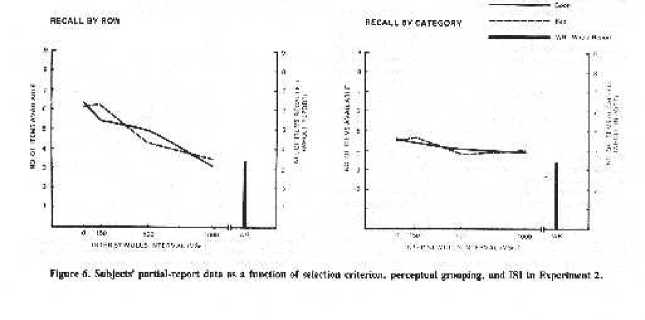Procedure. In order to minimize any effect of the order of testing, the six subjects were
tested in the order (from left to right) depicted in Table 4. The six subjects were assigned
randomly to the three rows of Table 4. All subjects were given the whole-report task in
Session 4. Because the subjects were well practiced on partial report with a spatial
selection criterion, Session 1 was used for training the subjects on partial report with a
category selection criterion. Two sessions were devoted to each of the two kinds of
selection criteria. When the selection criterion was category information, the high,
medium, and low tones signified letters, digits, and symbols, respectively. Other aspects
of the procedure were identical to those employed in Experiment 1.
Table 4
Arrangement of Experimental Sessions in Experiment 2
Number of Session
|
Subjects |
1 |
2 |
3 |
4 |
5 |
6 |
|
2 |
PRa |
Sb |
Cc |
WRd |
C |
S |
|
2 |
PR |
C |
S |
WR |
S |
C |
|
2 |
PR |
S |
C |
WR |
S |
C |
aPR = practice session. bS = spatial location as partial-report cue. cC =category
information as partial-report cue. dWR = whole report.
Results
Data from the practice session were excluded when subjects' partial-report performance
was examined to see whether the perceptual grouping hypothesis could account for the
basic sensory fording. The analysis was a 2 (selection criterion) x 2 (perceptual grouping)
x 4 (ISI) factorial ANOVA with repeated measures on all of the factors.
The overall ANOVA revealed a significant ISI effect [F(3,15) = 36.21, p < .05], a
significant ISI x selection criterion interaction [F(3,15) = 7.97, p < .05], and a significant
ISI x perceptual grouping interaction [F(3,15) = 3.88, p < .05]. However, the ISI x
instruction x perceptual grouping three-way interaction (which was necessary for the
perceptual grouping hypothesis) was not significant (see Figure 6).

Figure 6. Subjects' partial-report
data as a function of selection
criterion, perceptual grouping,
and ISI in Experiment 2.
More intriguing information
1. The name is absent2. The name is absent
3. LOCAL CONTROL AND IMPROVEMENT OF COMMUNITY SERVICE
4. APPLICATIONS OF DUALITY THEORY TO AGRICULTURE
5. Social Irresponsibility in Management
6. The East Asian banking sector—overweight?
7. The name is absent
8. Can we design a market for competitive health insurance? CHERE Discussion Paper No 53
9. Robust Econometrics
10. FOREIGN AGRICULTURAL SERVICE PROGRAMS AND FOREIGN RELATIONS